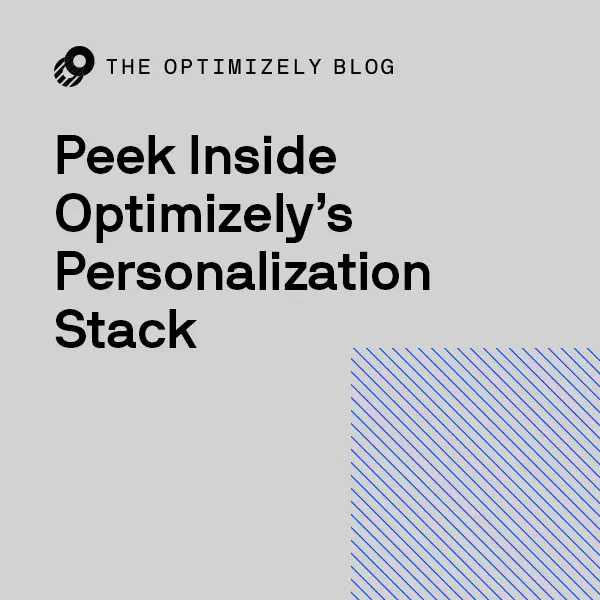Building a Modern Marketing Stack at Optimizely: Personalization & Extensions
Our marketing team’s goal is to provide a website experience that helps each visitor understand how Optimizely can help them reach their business goals. Our hypothesis has always been that getting relevant information in front of the user faster would result in an increase in leads.

Brad Taylor

This is the second part in a 4-part series about how Optimizely has rearchitected our marketing stack to support experimentation and personalization.
One way we work to achieve this goal is to use Optimizely’s Personalization capabilities to optimize the customer experience. For us, personalizing the user experience means surfacing relevant content to key user segments in order to increase engagement or conversion. We’ve built personalization into our website with a few key pieces of technology.
There are multiple components to any personalization strategy. I’ll share examples of how we have refined our strategy, but we follow four key steps:
Step 1: Unify and enrich customer data
Step 2: Build audience segments
Step 3: Develop customized campaigns
Step 4: Measure and optimize
Our first step in creating audience segments was unifying and enriching our customer data with the following main data sets:
- First Party Data (dynamic customer profiles, a feature in Optimizely, pull information from Salesforce and Marketo such as the user’s account and plan, how many experiments they have run and which webinars they have attended)
- Third Party Firmographic Data (using Demandbase integration with Optimizely to create segments based on industry, website traffic and company size)
- Behavioral Data (what users actually engage with on the site)
When we launched Optimizely X with personalization in 2016, we leveraged all of these data sets to build out audience segments to create personalized experiences, starting with our homepage. (You can read the full post with that story here). In setting up multiple campaigns over the years, it became clear to us that we could save a lot of time by simply reusing some of our most frequently used code snippets. A hack week project from our engineering team led to Extensions, which became the central way for us to launch experiments and personalization campaigns.
Extensions: Reusable Templates for Making Changes in the Optimizely Visual Editor
Extensions are reusable components that allow non-technical teams to run experiments on their websites. Your developers simply build out a template in which they can select a range of elements for non-developers to customize such as text, imagery, call-to-action and background color. Teams with limited technical resources can reuse them without needing to know how to code. We use Extensions for all ongoing personalization campaigns at Optimizely, saving us countless hours of development.
Here are a few examples of how we’ve combined Extensions with audience data to personalize content for our website visitors:
Example 1: Personalization for User Journey (Top of Funnel vs. Middle vs. Bottom)
We regularly surface our best content to specific relevant segments. For example, when a user first comes to the site, and we want to educate them about why experimentation is so powerful, we might promote a Harvard Business Review article: the Surprising Power of Experimentation. Once they have read that article, we want to promote more ideas and push them further down the funnel with our Big Book of Experimentation.
We customize the content using Extensions. These include different floating promos, from modals that take over the entire page to boxes that slide in from the bottom, top, and both sides of the site. We experiment with when to show the promo—on page load or after the visitor has scrolled to a certain depth. We are constantly coming up with new ways to get information in front of our users, without taking away from the experience of the site.


Example 2: Symmetric Messaging
The concept of symmetric messaging is to keep specific ad or promotional messaging and imagery consistent throughout a user journey. For instance, if someone searches for split testing, we make sure the results page or landing page text matches their intent, using the phrase they entered: ‘split testing.’ You can easily set this up by creating an audience that looks for the utm_campaign query parameter that matches the ad campaign you set up in your ad platform. Doing this helps avoid the messaging and imagery disconnect that often happens in paid advertising campaigns. We saw a 39% increase in conversions from visitors to leads in our first experiment with symmetric messaging. Read more about the concept in this blog post.

Example 3: Personalized Messaging for Existing Customers
When we announced in 2017 that we were transitioning all of our customers to the new Optimizely X platform, we wanted a quick way for our existing customers to get in touch with their customer success manager if they had any questions or concerns to help ease the transition.
We tapped into first party Salesforce data about which customer was assigned to which customer success manager, and created a personalization campaign using our dynamic customer profiles feature. The campaign also allowed the user to quickly send an email so that the success manager could quickly answer any questions. This helped reduce support requests and users filling out the contact sales form with questions about the transition.
Data that we already have about our own customer base allows us to do even more personalization based on product usage. This helps reduce unnecessary support and sales development costs.
Leveraging Optimizely’s features like Extensions and Personalization has enabled us to reduce support requests, accelerate the buyer journey, and serve a more tailored experience to website visitors. It’s become an essential part of our marketing stack, along with content management and analytics.
Next time we will dive into how we used experimentation to optimize our lead generation forms to increase our North America conversion rates 300%
